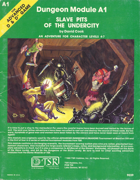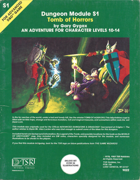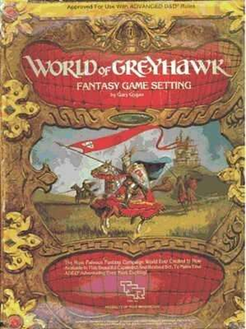 The World of Greyhawk is one of the oldest fantasy RPG settings, and grew out of the personal campaign of Gary Gygax, the co-creator of Dungeons & Dragons. In previous articles, I’ve discussed its origins, and the updates to the setting. In this article, I’ll discuss its adventures.
The World of Greyhawk is one of the oldest fantasy RPG settings, and grew out of the personal campaign of Gary Gygax, the co-creator of Dungeons & Dragons. In previous articles, I’ve discussed its origins, and the updates to the setting. In this article, I’ll discuss its adventures.
Many campaign settings are defined by their sourcebooks. Greyhawk rarely had a sourcebook, although some came out during the 2nd Edition era. Instead, Greyhawk is mainly defined by its adventures. The campaign setting sets are excellent, no doubt, but they are mostly bare-bones in detail. Why? Because the management at TSR expected that DMs would place their existing campaigns into Greyhawk. So, you’ve got a town and a dungeon designed? Here’s a lot of very diverse realms! Pick the one you like, and your campaign will fit there!
There are several themes present in the campaign setting products which DMs could use to create their own adventures. In particular, the threat of Iuz, the Great Kingdom, and the lingering memories of the Twin Cataclysms. In addition, Greyhawk is a medieval realm with many squabbling kingdoms, giving rise to lots of potential conflicts the players could become involved in. (Comparatively, the Forgotten Realms are comprised of vast tracts of wilderness). However, these are rather bare in details. Instead, almost every early release in Greyhawk was an adventure. And those defined the setting.
Here’s a few of the important ones.
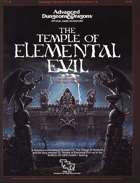 Village of Hommlet and Temple of Elemental Evil (T1, T1-4)
Village of Hommlet and Temple of Elemental Evil (T1, T1-4)
In the forest near to a small settlement named Hommlet, agents of “Elemental Evil” set up a vast temple. There, a great army of evil men, orcs and other dangers gathered. At the battle of Emridy Meadows, the forces of Good (led by the armies of Verbobonc, Furyondy and Veluna) defeated the forces of Elemental Evil, and the temple was cast down… but not destroyed.
This sequence of adventures details the second rise of the Temple, where the heroes discover, first, agents of the Temple in Hommlet, and then travel to the ruins of the Temple to destroy the new cult gathering there.
What’s particularly interesting about “Elemental Evil” is that it’s all a great sham perpetrated by Zuggtmoy, demoness of Fungi for her own power. Zuggtmoy was trapped within the temple when it fell, and our heroes have a chance to confront her there.
The adventure is flawed; Gary Gygax was unable to complete it before he was forced out of TSR, and it can become a repetitive dungeon crawl, but the importance of the adventure to the setting can’t be underestimated. Later on, Monte Cook would rewrite large portions of the backstory of the temple, giving a new rationale for its existence, as part of his Return to the Temple of Elemental Evil adventure. His backstory was used in the Forgotten Realms take on the adventure in 5E: Princes of the Apocalypse.
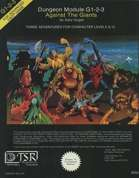 Against the Giants and Descent into the Depths of the Earth (G1-3, D1-3, Q1)
Against the Giants and Descent into the Depths of the Earth (G1-3, D1-3, Q1)
The very first AD&D adventure produced was G1, Steading of the Hill Giant Chief. This sequence of adventures begins with the adventurers gathered (possibly unwillingly) and sent against the strongholds of several giant tribes that have been raiding into the lands of Geoff and the Yeomanry (part of the Sheldomar Valley region). On their own, they’re good examples of assaults against monster lairs, which each expedition becoming more difficult as the intelligence and organisation of the giants increases.
However, there’s a major revelation at the end of the third adventure: The giants were actually urged into committing these attacks by the drow – dark elves that were banished beneath the surface of the Oerth many years ago, and now are nothing but legends. The story continues as the heroes chase the drow down to their hidden Vault deep underneath the surface, and may even find the heroes venturing into the lands of Lolth, the evil spider-queen demoness that rules the drow.
This was the first time the drow appeared in a D&D product. While later players might find them overused and part of the standard monster tool-kit, in their first appearance they were very mysterious, possessing unusual powers and equipment. Tentacle rods and elven chain that disintegrated in the light of the sun!
The Vault of the Drow, where various noble factions squabbled against each other, was the inspiration for the Forgotten Realms drow city, Menzoberranzan. It’s much less detailed.
Of particular interest to D&D lore: the rebel drow that spawned the conflict do not, in fact, serve Lolth, but an “Elder Elemental God”. Further revelations on that deity were not forthcoming, due to Gygax leaving TSR. Later writers came up with a new explanation, which doesn’t quite fit with what’s presented here.
From a hidden fortress on the Pomarj peninsular, slavers raid the civilised lands and carry away citizens of those lands to become slaves. In this series of adventures, you need to visit different outposts of the slavers until you discover their hidden Aerie and can confront their rulers.
I find this a lesser series of adventures, but one covering a topic that has rarely been revisited. The final adventure begins with the heroes captured and stripped of their equipment; they must then escape some underground caverns using their wits.
The Tomb of Horrors was designed as an adventure to test players who thought they knew how to play D&D, but whom Gygax thought just had permissive DMs. It introduced the figure of Acererak, a decayed lich whose last remnants survived in this tomb. When played using the original rules, it’s a death trap. (I don’t recommend any of the conversions to later editions; they typically tone down the deadly traps too much!) Unlike how Acererak is presented in later lore, he’s not a mastermind villain here. (That status can be attributed to Bruce Cordell with his Return to the Tomb of Horrors adventure, which is key to the later Tomb of Annihilation presentation).
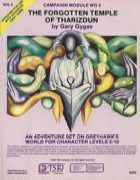 Lost Caverns of Tsojcanth and Forgotten Temple of Tharizdun (S4, WG4).
Lost Caverns of Tsojcanth and Forgotten Temple of Tharizdun (S4, WG4).
The Lost Caverns introduced the figure of Iggwilv, a witch who once ruled Perrenland and surrounds. She also happened to be the mother of Iuz, the evil demon who is one of the major antagonists of the World of Greyhawk setting. It’s a dungeon crawl with a lot of new monsters – at least, they were new then. Iggwilv also had a spellbook with many unique spells (some later made their way into regular books) – the Demonicon of Iggwilv.
As a side-trek accessible from the Lost Caverns, the characters could progress to the Forgotten Temple. This appears to be an abandoned temple filled with monsters, but things get stranger and stranger as the characters descend further into its depths. In the inner Cyst, our heroes get to see the chained form of Tharizdun, a god of pure evil who, if released, would destroy reality. (This actually happens in Gygax’s Gord the Rogue books!) Tharizdun would prove to be tremendously important for further work in Greyhawk. It’s nice having an ultimate bad guy!
Along the way, Tharizdun got combined with the Elder Elemental God (or Elder Elemental Eye), despite the two being distinct forces in their original conception. This combined deity is then used in the follow-ups to the Elemental Evil story, both here and in the Realms.
That’s enough of a summary for now – I’ll revisit the next wave of Greyhawk adventures in a later post!

